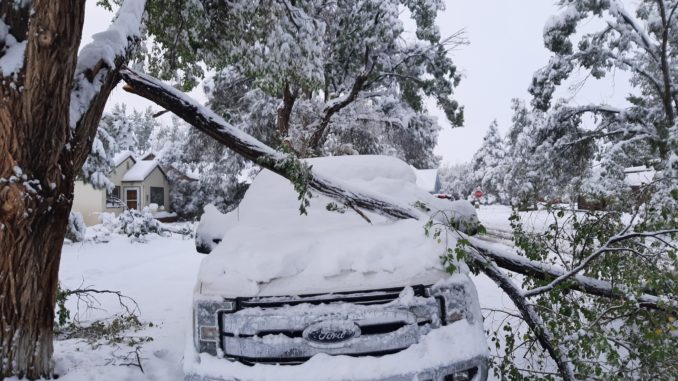
The Colorado State Forest Service is offering tips for dealing with storm-damaged trees currently statewide as a cold front brought high winds and wet and heavy snow to the state, damaging trees.
State residents who are dealing with broken tree limbs may be taking into consideration how to protect and repair them. Additionally, though the first choice might be to start cutting a damaged tree, homeowners should assess the situation to prevent hurting themselves or further damaging the tree according to Vince Urbina, urban and community forestry manager for the Colorado State Forest Service (CSFS).
Tips for dealing with snow and wind-damaged trees from Vince and the CSFS are as follows:
- Check for hazards. Before approaching a tree, examine your surroundings to avoid making contact with downed utility lines or standing under broken, hanging branches. Contact your utility company if a tree is affecting power or other utility lines.
- Contact city officials if necessary. Trees between the street and a city sidewalk may be the responsibility of city crews.
- Assess the damage. If a tree is healthy overall and still possesses its leader (the main upward branch), most of its major limbs and 50 percent or more of its crown, the chance is good for a complete recovery.
- Be careful knocking snow off branches. This may cause the branches to break. If you must remove snow, gently push up on branches from below to prevent adding additional stress.
- Remove broken branches. This minimizes the risk of decay and insects or diseases entering the wound. Prune at the branch collar– the point where a branch joins a larger one – and be mindful of potential pent-up energy if the branch is twisted or bent.
- Don’t over-prune. With the loss of some branches, a tree may look unbalanced, but most trees quickly grow new foliage that hides bare areas.
- Don’t try to do it all yourself. If the job requires running a chainsaw overhead, sawing from a ladder or removing large branches or entire trees, contact an insured, certified arborist.
For more information regarding tree care and protection, visit: csfs.colostate.edu or to find an ISA-certified arborist, visit www.isa-arbor.com/
Support Northern Colorado Journalism
Show your support for North Forty News by helping us produce more content. It's a kind and simple gesture that will help us continue to bring more content to you.
BONUS - Donors get a link in their receipt to sign up for our once-per-week instant text messaging alert. Get your e-copy of North Forty News the moment it is released!
Click to Donate